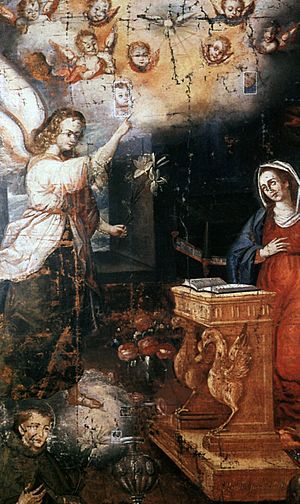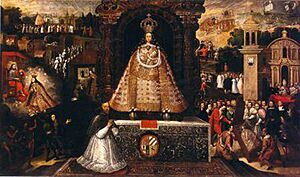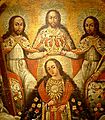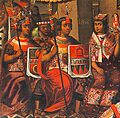Cusco School facts for kids
The Cusco School (also called Escuela cuzqueña or Cuzco School) was a special way of painting that started in Cusco, Peru. Cusco was once the capital of the Inca Empire. This art style grew during the time when Spain ruled Peru, from the 1500s to the 1700s. It wasn't just in Cusco; it spread to other cities in the Andes mountains, and even to places that are now Ecuador and Bolivia.
Many paintings from the Cusco School are still around today. Most are in Cusco, but you can also find them in other parts of Peru, in a town called Calamarca in Bolivia, and in museums in Brazil, the United States, and England.
Contents
History of the Cusco School
This art style began after the Spanish took over Peru in 1534. It was the first place in the Americas where European painting skills were taught in a regular way. Spanish and other European artists helped shape the Cusco School early on, especially when the Cathedral of Cusco was being built.
A big change happened when the Italian painter Bernardo Bitti arrived in 1583. He brought a style called Mannerism from Europe. This style often showed figures that looked a bit stretched out, with light shining brightly on them. During his time in Cusco, Bitti created important works like The Coronation of the Virgin and the Virgen del pajarito.
Another important artist of this early period was Luis de Riaño, who came from Lima. He was very influential in Cusco between 1618 and 1640. He painted murals in churches, like those in Andahuaylillas. Diego Cusihuamán was another key mural painter in the early 1600s.
Later, the Baroque style became popular in Cusco painting. This was influenced by artists like Francisco de Zurbarán and Flemish art from Antwerp. Marcos Ribera, born in Cusco around 1830, was a main artist of this style. You can see some of his paintings in the church of San Pedro.
As the 1600s ended, more local artists from the Quechua people and those of mixed Spanish and Indigenous heritage (called Mestizos) became active. This is when the term "Cusco School" truly described this art movement. This art was "Cuzqueña" not just because it was made by local artists, but because it started to develop its own unique look, moving away from European art trends.
Unique Cusco Style
This new Cusco art style had special features. Artists started including everyday scenes, like the Corpus Christi procession. They also painted Andean plants and animals for the first time. You can also find paintings of Indigenous leaders and family trees.
Artists sometimes showed a different way of looking at space in their paintings, not always using perfect perspective. They also loved using very bright, strong colors.
A major event happened in 1688. There was a big disagreement among the painters. The Indigenous and Mestizo artists left the main painters' group. They said they were being treated unfairly by their Spanish colleagues. After this, these local artists were free to paint what they felt and how they saw the world.
One of the most famous sets of paintings from the Cusco School is the Corpus Christi series. There are sixteen paintings that were originally in the church of Santa Ana. Now, most are in the Museum of Religious Art of the Archbishopric of Cusco. These paintings are masterpieces because of their rich colors and detailed drawings. They also show a lot about the different people and daily life in Colonial Cusco.
The most important Indigenous painter was Diego Quispe Tito. He was born near Cusco in 1611 and painted until the end of the century. In his work, you can see the unique features of Cusco painting. He used perspective in a new way, and landscapes became more important. He often painted many birds in leafy trees. Some people think the birds, especially parrots, were a special sign referring to Inca noble families.
Much of Quispe Tito's best work is in the church of his hometown, San Sebastián. This includes a series of twelve paintings about the life of St. John the Baptist. He also painted two large canvases of Saint Sebastian. Another famous work is his Zodiac series, painted for the Cathedral of Cuzco around 1680.
Another great painter was Basilio Santa Cruz Pumacallao. He was also of Indigenous background, like Quispe Tito. But Santa Cruz followed the European Baroque style more closely. He was active in the second half of the 1600s. His best work is in the Cathedral of Cusco, where he decorated the walls. His painting of the Virgin of Bethelem includes a portrait of Bishop Manuel de Mollinedo y Angulo, who helped the Cusco Painting School grow.
The Cusco paintings became so famous in the 1600s that in the next century, it led to a unique business. Workshops started making many paintings quickly. Merchants would sell these works in other cities like Trujillo, Ayacucho, Arequipa, and Lima. They even sold them in places as far away as present-day Argentina, Chile, and Bolivia. For example, the painter Mauricio García signed a contract to deliver about 500 paintings in seven months! These were called "ordinary" paintings, different from the more detailed and colorful "fine brocateado" style.
The most important artist of the 1700s was Marcos Zapata. He painted over 200 works between 1748 and 1764. His best works are the fifty large paintings that decorate the high arches of the Cathedral of Cusco. These paintings are known for having lots of plants and animals as decorations.
Artists of the Cusco School
Cusco School paintings were a form of religious art. Their main goal was to teach people about the Roman Catholic faith. The Spanish wanted to convert the Incas to Catholicism. So, they sent religious artists to Cusco. These artists started a school to teach Quechua people and Mestizos how to draw and paint with oils. The name "Cusqueña" isn't just for artists from Cusco or Indigenous artists. White Spanish people born in the Americas (called Criollos) also took part in this art tradition.
Bishop Manuel de Mollinedo y Angulo was a major supporter of the Cusco artists. He collected European art and let Peruvian artists study his collection. He also helped artists like Basilio Santa Cruz Pumacallao, Antonio Sinchi Roca Inka, and Marcos Rivera with money and support.
Style of Cusco Paintings
The special features of the Cusco style are thought to have started with the Quechua painter Diego Quispe Tito.
Cusco paintings are known for:
- Using only religious subjects.
- Not always using perfect perspective.
- Using a lot of red, yellow, and earth colors.
- Using lots of gold leaf, especially on paintings of the Virgin Mary.
Even though Cusco painters knew about European art from places like Byzantium, Flanders, and Italian Renaissance art, their works were more free. They used bright colors and sometimes dramatic, changed images. They often added local plants and animals from their homeland into their paintings.
Warrior angels became a very popular image in Cusco paintings.
Many Cusco paintings were created without the artist's name being known. This was because of older traditions that saw art as a community effort. One of the last known artists of the Cusco School was Marcos Zapata (around 1710–1773). Other known artists include Diego Cusihuamán, Gregorio Gamarra, Basilio Santa Cruz Pumacallao (1635–1710), and Antonio Sinchi Roca Inka. The Master of Calamarca, who worked in Bolivia in the 1700s, is also connected to this school.
Where to See Cusco Paintings
Most Cusco School paintings are in Cusco, especially in the Cusco Cathedral. You can also find them in other parts of Peru, in Calamarca (Bolivia), and in museums in Brazil, the United States, England, and the Colonial Art Museum of Bogotá. The Lima Art Museum and the Inca Museum also have important collections.
Many paintings from the Cusco School still exist from the Colonial period. In recent years, more and more art collectors and museums want to buy these paintings. In 2010, the American government returned two Cusco and Lima style paintings to Peru. They had been brought into the United States illegally in 2005.
Cuzco School artists
- Luis de Riaño 1596 — c. 1667, Peru
- Basilio de Santa Cruz Pumacallao, 1635–1710, Peru
- Antonio Sinchi Roca Inka, 17th century, Peru
- Diego Cusi Huamán, 17th century, Peru
- Diego Quispe Tito, 1611—1681, Peru
- Marcos Zapata, c. 1710—1773, Peru
- Master of Calamarca, 18th century, Bolivia
Miscellaneous
Today, local Peruvian artists still paint copies of Colonial Cusco paintings. They sell these to tourists.
See also
 In Spanish: Escuela cuzqueña de pintura para niños
In Spanish: Escuela cuzqueña de pintura para niños
- Ángeles arcabuceros
- Art of Latin America
- Art of Peru
- Latin American artists of indigenous descent
Images for kids
-
The Last Supper, 1753, by Marcos Zapata, in the Cuzco Cathedral. The festive animal to be consumed is a guinea pig.
-
Archangel Uriel, anonymous, 18th century -
The Marriage of Captain Martín García de Loyola and the Inca ñusta Beatriz Clara Qoya, daughter of Sayri Túpac; parents of the first Marchioness of Oropesa. 17th century painting located in the Church of la Compañía de Jesús, Cusco.
-
The Legend of Santa Sophronia, circle of Diego Quispe Tito, 2nd half of the 17th century (Brooklyn Museum of Art)
-
Example of Bolivian painting (part of the Cusco School): an Arquebusier Angel; by Master of Calamarca; 17th century
-
Christ Carrying the Cross, called "The Lord of the Fall", made in Cusco, ca. 1770–75, at the Metropolitan Museum of Art.















